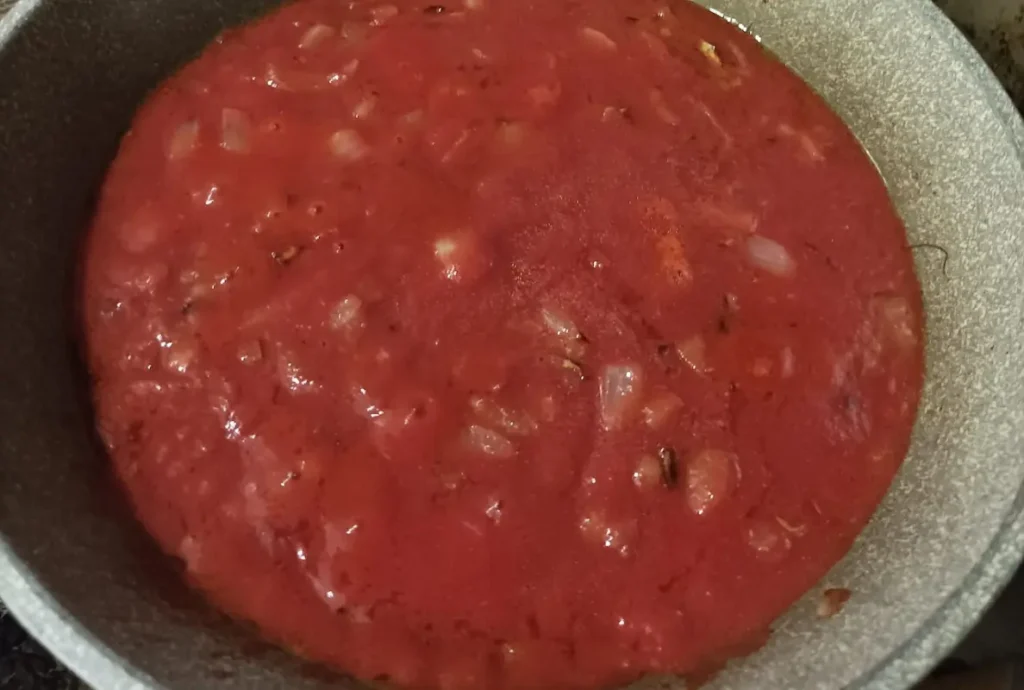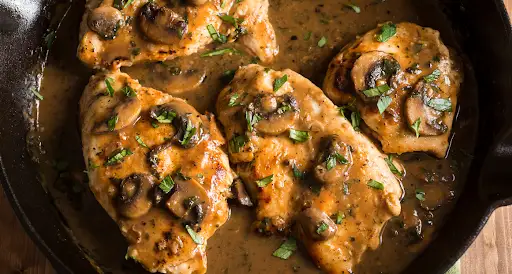This week I’m trying some new recipes. Yesterday, I went with this paccheri pasta with nduja and ricotta cheese, and I think I’ve found a new comfort food.
It’s tasty. It’s spicy. And it’s cheesy. The Holy Trinity of my favorite meals.
It’s from Southern Italy, and although it requires some more steps than the quick pasta dishes that I recently shared, it’s still a very easy recipe, that requires only some good-quality ingredients.
LFG!

What you need
This recipe has a strong local identity, and many of its ingredients are tied to southern regions of Calabria and Campania.
Here’s what you need.
Paccheri pasta: it’s a type of pasta made from durum wheat semolina, shaped like giant macaroni. Their name comes from the ancient Greek for “full-handed,” which gives an idea of how big they are. They are very common in Neapolitan cuisine. If you can’t find it, use regular-sized macaroni, or the largest kind of tubular pasta you can get your hands on.
‘Nduja: is a soft and spicy sausage made from the fatty parts of pork and Calabrian chili peppers, stuffed into a natural casing and then smoked. It is said to have originated in the town of Spilinga, and is one of the most famous Calabrian specialties.
I don’t know how easy it is to find PGI ‘nduja in the US, but Chuck shared a ‘nduja croquettes recipe so I guess it’s not impossible.

Grated caciocavallo cheese: a salty hard cheese typical of the southern Italian regions, made from cow’s milk and aged by a special process that involves hanging it from a rope. It is not the easiest cheese to find outside its places of origin, but it has such a distinctive flavor that I don’t think I can suggest any good alternatives.
Onions: this recipe is traditionally made with red Tropea onions, which are native to the same area as ‘nduja. If you don’t have any, get the freshest onions from your local grocery store.
Ricotta cheese: there are no local recommendations for this ingredient. Simply choose a good quality one.
Tomato puree: when it comes to vegetables, unless the recipe calls for specific ones, I think local is better. As with ricotta, the important thing is to choose a good puree, one that you would also like on its own.
Olive oil, salt, and ground pepper: you’ll need these to season the dressing and salt the pasta cooking water. I used a mix of 4 kinds of pepper I had at home, but ground black pepper is more than enough.
Method
Now that we have all the ingredients, let’s make our pasta with ‘nduja & ricotta.
The preparation phase is simple. All you have to do is:
- Peel and dice the onion
- Separate the ‘nduja from its casing and cut it into pieces. You don’t need to make them small or precise: they will melt in the tomato sauce.
- Grate the caciocavallo cheese.
- Fill 3/4 of a pot with lukewarm water bring it to a boil.

If you want to start right away, you can do point 2 later, in the middle of the process.
Now, let’s turn on the heat.
Step 1: toss the diced onion into a saucepan with a drizzle of olive oil, and let it brown.
Step 2: add the tomato sauce and simmer for about 8 to 10 minutes.

Step 3: at this point, the water should be boiling. Add a handful of coarse salt, wait another minute, and drop in the paccheri pasta.

Step 4: if you haven’t done it before, cut the ‘nduja into pieces and let it simmer in the tomato puree for about 5 minutes. It will melt, creating a delicious, spicy sauce.

Step 5: in a bowl, mix the ricotta with the grated caciocavallo cheese and ground pepper. I’ve used a little more cheese than the amount listed in the recipe card below, so I had to smooth the mix out with a small amount of pasta cooking water.

Step 6: add the ricotta mix to the saucepan and let it simmer over low heat for a couple of minutes, stirring continuosly.

Step 7: now, all you have to do is to wait for the pasta to be ready. If you’re afraid to burn your sauce, set it aside from the heat for a while.
When the pasta is al dente toss it into the saucepan and mix over medium heat for another minute or two.
Serve your paccheri with ‘nduja & ricotta and add to each plate an extra sprinkle of grated cheese.
What to serve with it
This recipe is a complete meal. It has carbs, meat, dairy and vegetables. So, I would serve it with just a simple side salad. A Light Salad too. A salad with crisp, fresh greens and a citrusy vinaigrette can provide a refreshing contrast to the rich pasta. Ingredients like arugula, cherry tomatoes, and lemon zest can add a tangy note.
Nothing complex, you can simply use the same vegetables along with some lettuce or arugula leaves.
If you’re not on a diet, I’d also serve some bread to make scarpetta. It is the act of cleaning the plate from all the leftover dressing by using pieces of bread and then eating it. Crusty Bread is good too. A loaf of Italian or sourdough bread can be a wonderful addition. Serve it warm with olive oil for dipping to enhance the Italian flair of the meal.
Wine: Go for a red full-bodied wine from Southern Italy. A Nero D’Avola should be fine. Consider pairing it too with a chilled white wine like Pinot Grigio or Sauvignon Blanc. The crisp acidity can cut through the richness of the ‘Nduja and Ricotta cheese, providing a balanced palate.
But when serving a dish as rich and flavorful as pasta with ‘Nduja and Ricotta cheese, the accompaniments can truly elevate the dining experience. ‘Nduja, a spicy and spreadable pork salumi from Italy, adds a unique kick, while Ricotta cheese provides a smooth, creamy texture.
Here are some other perfect pairings that can complement this indulgent dish:
Roasted Vegetables: Simply roasted vegetables such as asparagus, bell peppers, or zucchini can offer a healthy and flavorful accompaniment. Seasoning with just olive oil, salt, pepper, and a touch of garlic will keep them in harmony with the pasta.
A Simple Protein: If you want to add more substance, a simply prepared protein like grilled chicken or shrimp can be an excellent choice. Keep the seasonings minimal to let the pasta remain the star of the meal.
Fruit-Based Dessert: For dessert, consider something light and fruity like a lemon sorbet or a fresh berry compote. This can cleanse the palate and provide a sweet finish without overwhelming after such a rich main course.
Herbed Garlic Bread: For those who love a garlicky touch, herbed garlic bread can enhance the flavors of the pasta without overpowering them.
Olives and Artichokes: Serving a side of marinated olives and artichokes can add an authentic Mediterranean twist, offering both texture and flavor.
Pasta with ‘Nduja and Ricotta Cheese Recipe FAQ
Q: What is ‘Nduja?
A: ‘Nduja is a spicy, spreadable pork sausage from the Calabria region of Italy. It’s made with a mixture of pork, herbs, and spicy red peppers, giving it a unique, robust flavor.
Q: Can I substitute ‘Nduja with something else?
A: If you can’t find ‘Nduja, you can use a mixture of soft chorizo and chili flakes as a substitute. Adjust the spice level according to your taste.
Q: What type of pasta works best for this recipe?
A: You can use a variety of pasta shapes for this recipe. Penne, rigatoni, or fusilli are excellent options, as their shapes can hold onto the creamy sauce well.
Q: Can I make this dish vegetarian?
A: To make a vegetarian version, you can omit the ‘Nduja and add roasted red peppers and extra chili flakes for heat. You may also want to add some smoked paprika to mimic the smokiness of ‘Nduja.
Q: What type of ricotta cheese should I use?
A: Whole-milk ricotta cheese is ideal for a creamier texture, but you can use part-skim ricotta if you prefer a lighter option.
Q: How do I store leftover pasta?
A: Leftovers can be stored in an airtight container in the refrigerator for up to 3 days. Reheat gently on the stove or microwave, adding a splash of water or milk to reconstitute the sauce if necessary.
Q: Can I prepare this dish in advance?
A: You can prepare the sauce in advance and refrigerate it for up to two days. Simply reheat the sauce and cook the pasta fresh when you’re ready to serve.
Q: Is this dish kid-friendly?
A: The ‘Nduja can be quite spicy, so if you’re serving this to children or those with a sensitivity to heat, you may want to reduce the amount or choose a milder substitute.
Q: What wines pair well with this pasta?
A: A crisp white wine like Pinot Grigio or Sauvignon Blanc pairs wonderfully with this dish. If you prefer red, a light and fruity red like Chianti can also work well.
Q: Can I add other vegetables to this pasta?
A: Absolutely! Feel free to incorporate vegetables like spinach, peas, or sautéed mushrooms for added flavor and nutrition.
Recipe Card
Print
Pasta with ‘Nduja & Ricotta
5 Stars 4 Stars 3 Stars 2 Stars 1 Star
No reviews
- Author: Mortadella Head
- Total Time: 25 minutes
- Yield: 4 1x
Ingredients
12 oz paccheri pasta
5 oz ‘nduja
8 oz ricotta
2 oz grated caciocavallo cheese
1 red Tropea onion
8 oz tomato puree
a handful of coarse salt
a drizzle of olive oil
black pepper to taste
Instructions
- Peel and dice the onion
- Separate the ‘nduja from its casing and cut it into pieces. You don’t need to make them small or precise: they will melt in the tomato sauce.
- Grate the caciocavallo cheese.
- Fill 3/4 of a pot with lukewarm water bring it to a boil.
- Toss the diced onion into a saucepan with a drizzle of olive oil, and let it brown.
- Add the tomato sauce and simmer for about 8 to 10 minutes.
- At this point, the water should be boiling. Add a handful of coarse salt, wait another minute, and drop in the paccheri pasta.
- Add the ‘nduja to the tomato puree and let them simmer for about 5 minutes. It will melt, creating a delicious, spicy sauce.
- In a bowl, mix the ricotta with the grated caciocavallo cheese and ground pepper.
- Add the ricotta mix to the saucepan and let it simmer over low heat for a couple of minutes, stirring continuosly.
Now, all you have to do is to wait for the pasta to be ready. If you’re afraid to burn your sauce, set it aside from the heat for a while. When the pasta is al dente toss it into the saucepan and mix over medium heat for another minute or two. Serve your paccheri with ‘nduja & ricotta and add to each plate an extra sprinkle of grated cheese.
- Prep Time: 5
- Cook Time: 20
- Category: Pasta
- Cuisine: Italian









